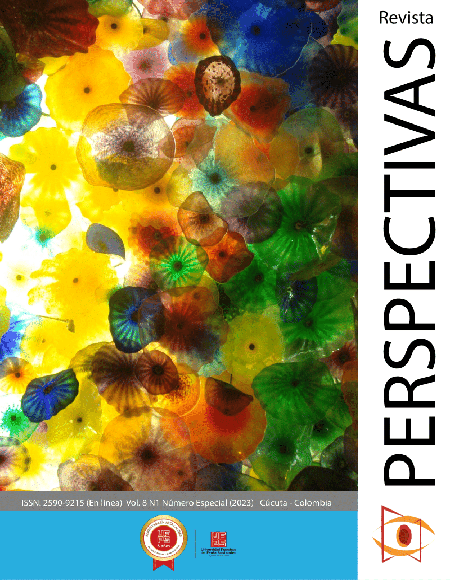Difficulties and errors in solving simple additive type problems
Dificultades y errores en la resolución de problemas de tipo aditivo simple
Main Article Content
This article is derived from a study whose objective is to identify the difficulties and errors that fifth grade students of the Libertad Municipal Educational Institution face when solving additive type problems, focusing on the first three categories of additive relationships proposed by Vergnaud (1991). The research adopted a mixed approach because it combined qualitative and quantitative methods. In the qualitative aspect, a detailed identification of the errors and difficulties in the students' resolution strategies and responses was carried out. On the other hand, in the quantitative approach, the entire population chosen for the study, composed of 32 students, was approached and statistical techniques were applied to analyze the collected data. To gather the necessary information, three problem questionnaires were administered, one for each of the additive relationships in question. As a result, a number of common errors were identified, including problems related to improper subtraction processing, use of incorrect operation, unconventional placement of subtraction terms, among others. Difficulties in understanding the statement, poor positional placement and alteration of the data provided in the statement were also observed. Based on the analysis of the identified errors, we continued with the characterization of the underlying difficulties that caused them. Consequently, this study provides significant data that can be used to improve mathematical problem solving skills, particularly those of an additive type. Knowledge of these difficulties and errors contributes to optimizing the teaching and learning process of mathematics, allowing us to more effectively address the specific challenges that students face in this crucial aspect of their academic training
Downloads
Article Details
Angulo, A., Pulido, N., y Molano, E. (2017). Estrategia de enseñanza para favorecer la comprensión del valor posicional. Rev. Edma 0-6: Educación Matemática en la Infancia, 6(1), 1-31 http://www.edma0-6.es/index.php/edma0-6 DOI: https://doi.org/10.24197/edmain.1.2017.1-31
Bedoya y Orozco (1991). El niño y es sistema de numeración decimal. Rev. Comunicación, lenguaje y educación, 11, 55-62. https://dialnet.unirioja.es/descarga/articulo/126224.pdf DOI: https://doi.org/10.1080/02147033.1991.10820980
Bonilla, M., Recalde, F., y Sanchez, N. (1999). Estructura aditiva y formación del profesores para la educacion básica. http://funes.uniandes.edu.co/12251/
Bracho, R. (2010). Viabilidad de la investigación en la educación matemática en España (tesis de doctorado). Universidad de Córdoba. https://fqm193.ugr.es/produccion-cientifica/tesis/ver_detalles/6660/descargar/
Butto, C., y Martínez, C. (2012). Abordaje basado en competencias: la resolución de problemas aditivos en el nivel básico. Rev. Horizontes Pedagógicos, 14(1), 4.
Campistrous, L. Rizo, C. (1997), Aprende a resolver problemas aritméticos. Editorial Pueblo y Educación.
Castro, E. (1991). Resolución de problemas aritméticos de comparación multiplicativa. Memoria de Tercer Ciclo (tesis de doctorado). Universidad de Granada.
Fuster, D. E. (2019). Investigación cualitativa: Método fenomenológico hermenéutico. Rev. Propósitos y representaciones, 7(1), 20-229. http://www.scielo.org.pe/pdf/pyr/v7n1/a10v7n1.pdf DOI: https://doi.org/10.20511/pyr2019.v7n1.267
Godino, J., Batanero, C., y Font, V. (2004). Didáctica de las matemáticas para maestros. https://www.ugr.es/~jgodino/edumat-maestros/manual/9_didactica_maestros.pdf
González, N., Riveros, J., y Diaz, A. (2022). Dificultades en la resolución de problemas aditivos simples en estudiantes de segundo grado. Rev. Góndola, Enseñanza y Aprendizaje de las Ciencias, 17(2), pp. 246-267. https://doi.org/10.14483/23464712.16876 DOI: https://doi.org/10.14483/23464712.16876
Hernández, R., Collado, C., y Baptista, M. (2014). Metodología de la Investigación (6ª ed.). McGRAW-HILL.
Hernández, R., y Mendoza, C. (2018). Metodología de la investigación: las rutas: cuantitativa, cualitativa y mixta. Ed. Mc Graw Hill educación
Ministerio de Educación Nacional-MEN. (2006). Estándares Básicos de Competencias en Lenguaje, Matemáticas, Ciencias y Ciudadanas Guía sobre lo que los estudiantes deben saber y saber hacer con lo que aprenden. https://www.mineducacion.gov.co/1621/articles-340021_recurso_1.pdf
Montero, L., y Mahecha, J. (2020). Comprensión y resolución de problemas matemáticos desde la macroestructura del texto. Rev. Praxis & Saber, 11 (26). https://doi.org/10.19053/22160159.v11.n26.2020.9862 DOI: https://doi.org/10.19053/22160159.v11.n26.2020.9862
Pérez, Y., y Ramírez, R. (2011). Estrategias de enseñanza de la resolución de problemas matemáticos. Fundamentos teóricos y metodológicos. Revista de Investigación, 35(73), pp. 169-194. https://www.redalyc.org/pdf/3761/376140388008.pdf
Polya, G. (1962): Mathematical discovery. Ed. John Wiley and Sons.
Portugal, M. J. S. (2008). Errores sobre el sistema de numeración decimal de estudiantes de magisterio. Rev. Investigación en Matemática XI, pp. 381-392. https://dialnet.unirioja.es/servlet/articulo?codigo=2697696
Puig, L. (1996). Elementos de resolución de problemas. Ed. Comares, col. Mathema
Reyez, P. (2017). El desarrollo de habilidades lógico matemáticas en la educación. Rev. Polo del Conocimiento, 2(4), pp. 198-209. https://polodelconocimiento.com/ojs/index.php/es DOI: https://doi.org/10.23857/pc.v2i4.259
Rico, L. (1995). Errores y dificultades en el aprendizaje de las matemáticas. http://funes.uniandes.edu.co/486/1/RicoL95-100.PDF
Rodríguez, M., Gregori, P., Riveros, A., y Aceituno, D. (2017). Análisis de las estrategias de resolución de problemas en matemática utilizadas por estudiantes talentosos de 12 a 14 años. Rev. Educación Matemática, 29(2), pp. 159–186. https://doi.org/10.24844/em2902.06 DOI: https://doi.org/10.24844/EM2902.06
Rodríguez, C., Sandoval, C., Inostroza, A., y Del Socorro, M. (2019). Estructuras semánticas de problemas aditivos de enunciado verbal en libros de texto mexicanos. Rev. Educación Matemática, 31(2), pp. 75–104. https://doi.org/1.24844/EM3102.04 DOI: https://doi.org/10.24844/EM3102.04
Segura, J. (2015). La utilización de los algoritmos de sustracción en educación primaria. Edma 0-6. Rev. Educación Matemática en la Infancia, 4(2), pp. 73-88. DOI: https://doi.org/10.24197/edmain.2.2015.73-88
Vergnaud, G. (1991). El niño, las matemáticas y la realidad. Trillas.







